- Home
- All Kinds of Palms
- Indoor Palms
Types of Indoor Palm Trees - A Guide
Thinking about types of indoor palm trees for your home?
We know the best palm tree types indoor for your home. The ones you could try out, and how they're successful.
Here, We're Always Palm Tree Involved! Studying & learning about the best types of indoor palm trees. Seeing which popular houseplants can help you make that indoor tropical look!
We've organized this guide to see the top indoor palms. Plus categories to consider!
SOME TERRIFIC EASY-CARE TYPES OF INDOOR PALM TREES:
(No! It's not a fake palm!!)
Feeling overwhelmed by so many palm trees?
You're not alone. We Understand your headaches! At Mission: Palm Trees you'll find clear answers to questions & Step-By-Step Guidance, from real people. With solutions to help. No puzzling shoptalk. No tiring research. So it's easy & fun for you.
Why Indoor Palm Trees? For Your Best Home Garden!
What's more perfect than potted palms!
For helping to purify the air. The palm leaves recycle the Carbon Dioxide (CO2) of your indoor spaces. Turning it into fresh oxygen!
Because that's what they exhale: Oxygen (O2). The opposite of what your body does, by exhaling CO2.They're Cleaning Your Indoor Air, too!
Remember that most types of indoor palms (if not all!) are sourced from a forest or swamp's understory. Meaning they grow beneath many taller trees, shrubs, and climbing vines.
Their normal is for not getting full sun, at all. This is why they can survive well indoors.
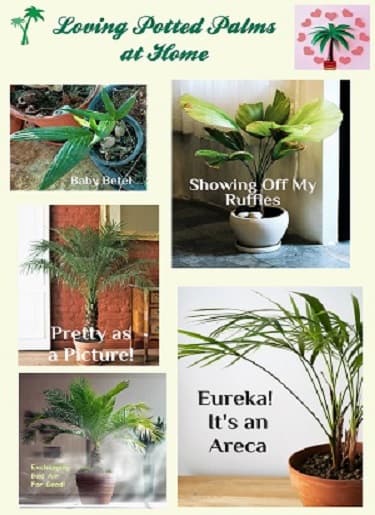
Whether for large spaces or small. See how they'll fit with types of indoor palm trees you'd like. We've organized this guide to help you figure out your own top indoor palm varieties.
What Types of Indoor Palm Trees are Best?
Think of indoor types of palm trees as being an ideal in your living space.
Small palms grow a maximum of 20 feet tall. But not all are suitable as Palm Trees in Pots for growing indoors.
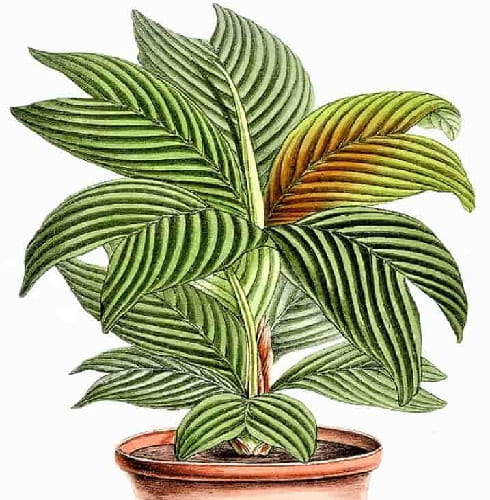 Liking This Stunner?!
Liking This Stunner?!Important Points for Types of Indoor Palms
Indoor Palm Plant Decisions:
- Is it known for doing well with low-light conditions? Or does it need bright light?
- Will the indoor humidity level, especially in winter, affect it poorly?
- Is it used to excess water & high humidity in its natural habitat?
- Does it have irritating or hurtful Palm Plant Parts?
- Such as spines, allergenic oils, harmful fruits, etc.
Even though they're small palms, indoor conditions won't necessarily be suitable for some species. A suitable, well-cared-for indoor palm tree can live for ten years. Maybe even more.
Because buying palm trees is an investment.
Mission: Palm Trees Update
-
Backyard Palm Tree Ideas Make Your Space Feel Like a Tropical Escape
Bring a resort feel home. Explore inspiring backyard palm tree ideas with themes like clustering, layering, and lighting designs for any space.
Guide to Different Types of Indoor Palm Trees
Which types of indoor palms are suitable for potting, then?
Look at palms that do well in low light conditions. Slow growing palms are a good start, so they don't quickly overgrow their container. We'll take you to those which do well inside, showing their size, advantages (or not!), and other tips.
But if you still have questions, you can always Contact Us. Most likely we can get you an answer.
A Kentia Palm is an Easy Care for Indoors
The scientific name is Howea forsteriana. Also called Kentia Palm. Known to easily be long lived & tolerate indoor conditions. Needs bright indirect light.
- Probably best in a large space, as its leaf span reaches up to 6'/2m long!
- Add mulchy humus to soil for durable health. But be sure it has good drainage.
- Needs medium amounts of regular watering.
Parlor Palm - One of the Best for Your Home
Chamaedorea elegans is also called Neanthe Bella.
Among the slow growers, its small size makes it an excellent choice. It's the most popular among types of indoor palms. Check its ideal conditions:
- Elegantly arching green fronds. The feathery leaflets get about two feet long.
- Bright indirect sunlight helps maintain this attractive looking palm.
- Caution for its susceptibility to spider mites!
- Its natural habitat is Mexican & Central American rainforests. See its watering needs:
Pygmy Date Palm Indoors Can Do Well - Easy Guide
Commonly referred to as the Miniature Date Palm or Robelini Palm.
Scientifically named Phoenix roebelenii. Popular choice for its fiber-matted trunk & feathery fronds. Its mature height is about 8ft/2.5m.
- In its natural habitat it likes full sun. Yet it can do well in indoor spaces by a western or southern window.
- No leaf production in growing season? Not good, as that can mean eventual death! It probably needs more light.
- How much water? Only just allow the moist soil to dry. That's the time to water again.
It's even a nice specimen for planting in Landscaping Around Taller Palms.
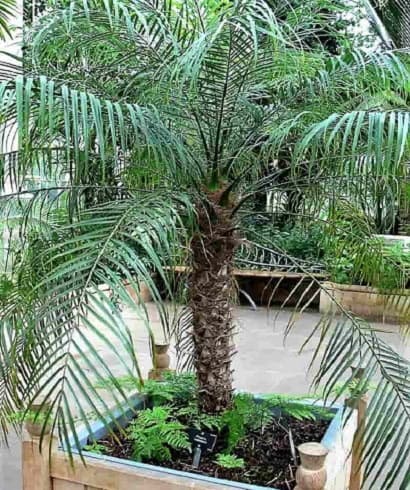 Waiting for You to Take It Home
Waiting for You to Take It HomePhoto: Prashanthns - CC BY-SA 4.0
The Areca Palm - Your Best Indoor Care Guide
Dypsis lutescens has a stylish look.
Among the most beautiful Types of Indoor Palm Plants. AKA Butterfly Palm, Yellow Bamboo Palm & Golden Cane Palm.
 Vintage Ad Invite to Come See (And Buy!) Their Areca Palms
Vintage Ad Invite to Come See (And Buy!) Their Areca PalmsThe Areca Palm gives instant tropical feel to any large room!
- Grows quickly up to heights of 15ft/4.6m. With a slender trunk.
- It needs bright light. Ideal choice for airy rooms.
- TIP: Situate it near a large westerly or southerly window, with sheer light filtering.
- Ensure it has well-draining soil. Otherwise Some Palm Problems could occur, like root rot.
Precaution: Susceptible to spider mites. Particularly with low humidity level in winter months.
Lady Palm - Easy Tip Guide for Beginning Indoor Gardens
Also been called Tall Lady Palm & even Bamboo Palm (as have many more!!).
Rhapis excelsa is compact, with multiple slender trunk stems. This one is perfection for hardy plants. So best as a type of indoor palm tree for beginners! Great low maintenance palm that's a lady survivor!
- Slow-growing plant in the palm world, eventually reaches about 10ft/3m high.
- Large, glossy fan-shaped fronds.
- No watering problems, with medium needs & well-drained soil.
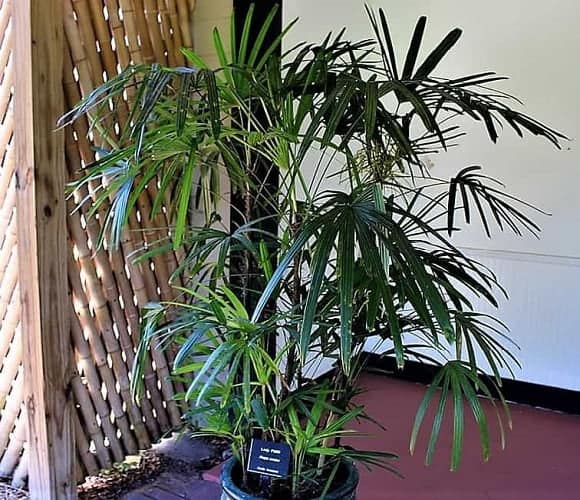 This Lady Sits Behind a Screen
This Lady Sits Behind a ScreenAt the Coastal Georgia Botanical Gardens in Savannah, GA
Photo: Michael Rivera - CC BY-SA 4.0
More Types of Palm Trees
Suitable as Indoor Plants
Even more we can show you!
These species are suited as potted types of indoor palm trees. They certainly don't want full sun. But do like bright indirect light, filtered through sheer draperies.
Cataract Palm Care To Help Them Grow Best
The Chamaedorea cataractarum is a water lover.
For in its natural habitat you'd find it along rivers & streams. Also called Cat Palm & Cascade Palm.
- Seems like a short trunk. Actually it grows below the soil, or just above.
- Full height can get to 6ft/2m. At a medium pace.
There are drawbacks for trying this for indoor spaces.
- Wants consistent watering & humidity. Even likes excess water & soggy roots!
- Plus tendencies for attacking by spider mites.
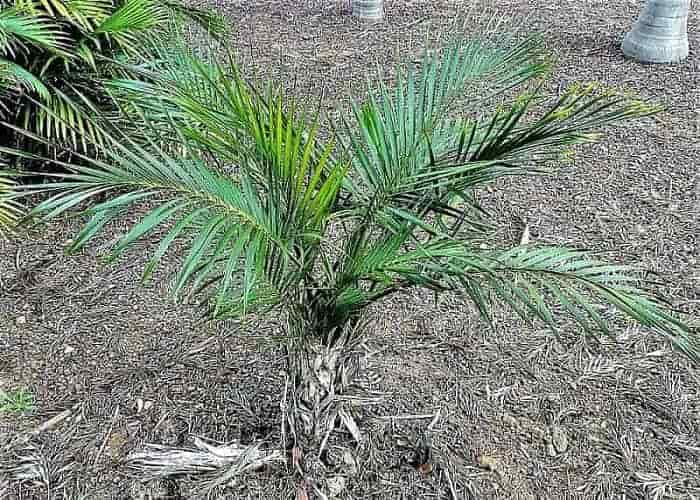 This small Cat Palm could fit In a nice container!
This small Cat Palm could fit In a nice container!Photo: Krzyszt Ziarnek - CC BY-SA 4.0
Hardy Bamboo Palms Brighten Up Any Home Garden
Chamaedorea microspadix - That "hardy" in its nickname is well earned!
If Harmed By Cold, it often regrows.
- Likes regular, moist soil, without totally drying out.
- As a clustering palm, regular pruning won't crowd it in the container.
- Does well with indirect sunlight.
An option is bringing it out to your patio in summer months with warm temperatures.
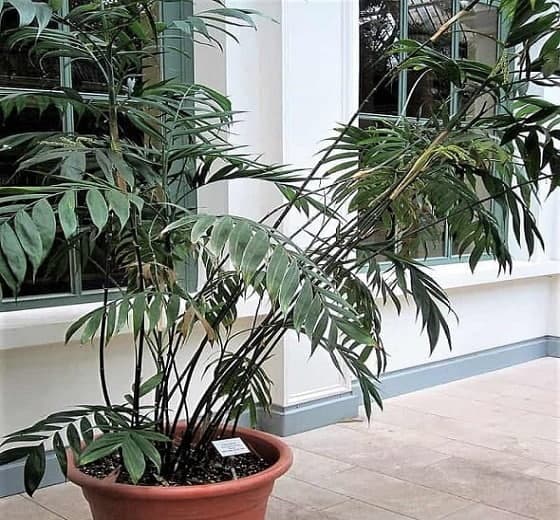 Going to Pot! At Palmengarten in Frankfurt, Germany.
Going to Pot! At Palmengarten in Frankfurt, Germany.Photo: Teddychen81 - CC BY-SA 4.0
Another Bamboo Palm That's Fine Indoors
Chamaedorea seifrizii is also called the Bamboo Palm (that's confusing, yes!), but also Reed Palm.
Has a crownshaft, if you can find it within its usually dense foliage!
- With slender trunk growth at each clustering stem. With feathery fronds growing leaflets with varying widths.
- Pruning Out Palm Stems carefully can beautify it.
- Grows pretty quickly with regular watering.
- One drawback is the inclination to get spider mites or pink rot during winter months!
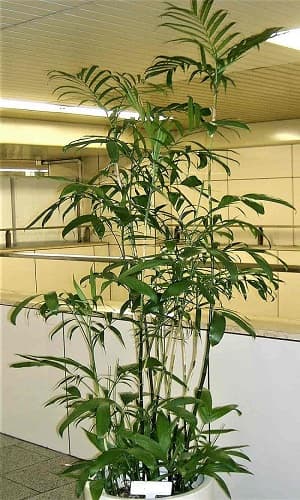 Delightful Indoor Specimen
Delightful Indoor SpecimenPhoto: Kenpei - CC BY-SA 4.0
Guide a Metallic Palm Tree With Easy Care
No, not related to the American heavy metal band!☺️ Which was newly formed in 1981.
In fact, Chamaedorea metallica was accepted by the Royal Botanic Gardens as of 1966, and scientifically named earlier.
Also called Fishtail Palm & Miniature Fishtail Palm. With popularity among collectors, now rare in endemic south Mexican rainforests.
- Per its name, bluish green leaves have a metallic glow.
- Be sure it's adequately watered & drains well, avoiding dry soil.
- Partial shade is the way to go.
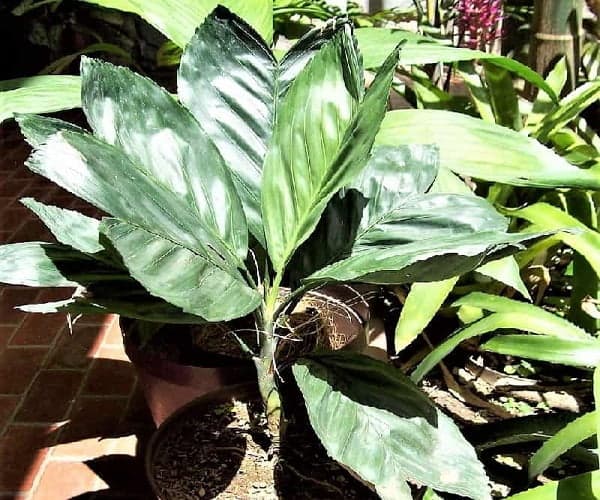 Metallic Palm Admired in Caracas Botanical Garden, Venezuela!
Metallic Palm Admired in Caracas Botanical Garden, Venezuela!Photo: Daniel Rengelm - CC BY-SA 4.0
Can the Chinese Fan Palm Grow Best Indoors?
Livistona chinensis is a popular choice for an indoor palm.
Particularly because it survives fine with indirect sunlight. Also called the Fountain Palm. But is it an excellent choice?
- Has a great tropical feel with beautiful dark-green fan-shaped fronds.
- Not often grown as indoor palms. They need large space & more light than most types of palms for inside.
- To get the best out of it, give it regular watering. Plus plant in soil with good drainage & some humus.
Alternate Types of Indoor Palm Trees
Types of Artificial Palm Trees for Indoors
Get the island paradise look with realistic artificial palm trees!
These types of indoor palms instantly add a tropical vibe to any room. You'll feel like you've already reached your vacation destination!
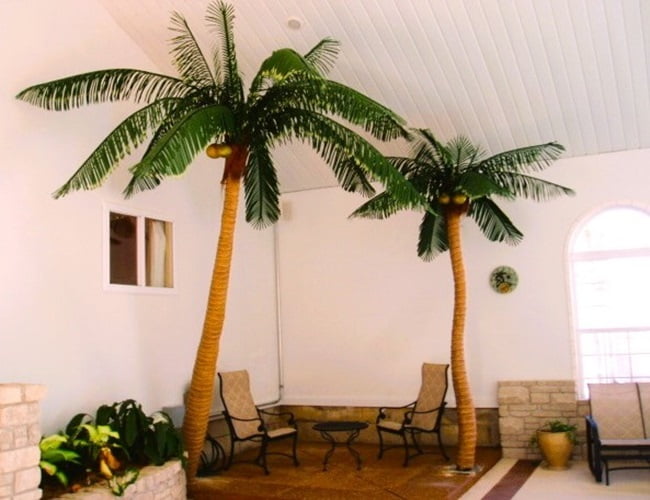 The Main Care a fake coconut palm needs: Dusting & Cleaning the fronds.
The Main Care a fake coconut palm needs: Dusting & Cleaning the fronds.Image: Xtremely Tropical @Flickr - CC BY-SA 4.0 Deed
Realistic-looking, artificial palm trees are easier care than real indoor palms.
- Don't worry about its light requirements.
- Pop them anywhere it works in your home decor.
- They'll last for years to come.
And don't forget, these types of Indoor Palms Require Almost No Maintenance.
Whether you’re looking for a tall palm for a grand entrance or an exotic palm plant for your living room. Check the selections we have for Artificial Palm Trees. Beauties to help create your tropical paradise inside your home!
Palm Tree Look-Alikes to Consider
Another option is choosing those plants that kinda look like palms.
But they're not a true palm. Even though "palm" is often in their name! Like the Sago Palm, the Ponytail Palm & the Yucca Palm.
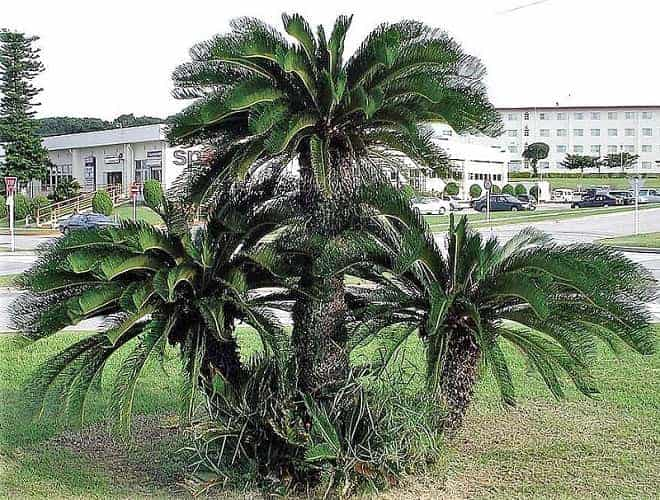 Not Actually a Palm, Even Though Called the Sago Palm.
Not Actually a Palm, Even Though Called the Sago Palm.Takeaways For Types Of Indoor Palm Trees
Indoor potted palms have benefits for your home.
Easily suited for growing in containers. Learn still more about caring for Types of Indoor Palm Trees with this Palm Plant Care Guide>.
You also have the typically hardy plants called palms, but they're not!
If you're looking for palms that don't need much care, an artificial palm can do the trick. Many are realistic looking & can be the trick for you!





